人教版英语第四单元教案
- 格式:doc
- 大小:58.11 KB
- 文档页数:9
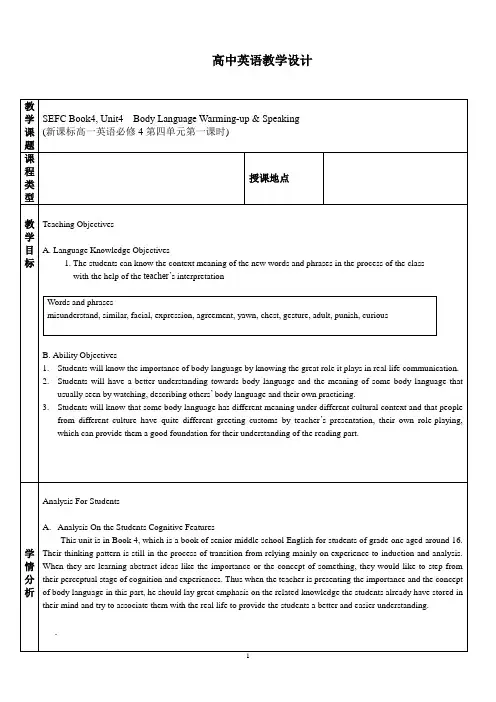
高中英语教学设计教学重难点Teaching FocusMake the students understand that body language has cultural diversity and there is no division of good or bad for the diversity.ChallengeMake sure that the students will have the awareness to use and try to understand others’ body language when they communicate with others in the future.教学准备A. A projectorB. computer for multimedia teaching教学方法Teaching methodsA. Asking-and-answering between the teacher and the studentsB.. Interaction among individuals, pair-work and group-workC. Task-based teachingD. Teacher’s demonstration and interpretationE. Role-playingF. Students’ discovery教学过程设计活动内容Step 2介绍身势语的重要性A.Telling Students the Story of Tai Lihua and Making Them Know theImportance of Body Language in Her Life ( 3 min )1.Present the pictures of Thousands of Hands Kwan-yin , and ask the students whether they know thegirl who dances in the front.2. Tell the students tell life story of Tai Lihua and ask them the question “What are the key factors forher success in her life?”The life story of Tai LihuaHer name is Tai Lihua(邰丽华). She is called a Fairy of Peach blossom(桃花仙子) by people. You knowshe is a deaf girl, but she is a wise, diligent, charming and energetic girl. She studied very hard and got two degrees of bachelors in university. She was famous as an artist for her wonderful performance. She is deafand dumb. But how did she get that great achievement and became a successful person? She loves life very much. We should learn from her spirit. Besides her hard working, body language plays a very importantpart in her life. We are all healthy people, sometimes we can use body language to express ourselves. Sowe should pay more attention to learning body languages.B.Showing the Students the Science Report of the Importance Body Language,Making Them Know That Body Language Is As Important For Us As ForDisabled Person Like Tai Lihua. ( 1 min )Some psychologist believe that we communicate 65% of our ideas and feelings without words! The shape of our bodies and faces, the movements and gestures we make, the clothes we wear, how near we stand to each other and whether we touch each other…all these communicate. we must study all these types of information if we want to truly understand what other people are saying.Step 3介绍不同类型的身势语() ( step 3 will use around 5 min )A. Showing the Students The Four Types of Body LanguageGestureFacial expressionEye contactPostureB. Guessing The Meaning of GesturesThe teacher show the students a series of pictures of a man using different gestures, and the students are supposed to say their meaning.C.Acting Out By GesturesThe teacher show the students some English words and ask them to act them out together by using gestures.Victory!Ok !Be quiet!You!D. Chasing the Right WordThe teacher will show the students a series of pictures describing different facial expressions and askthe students to choose the right word for each.E. Matching the Right Interpretation Of the EyesThe teacher will present students several pictures of eyes and ask the students to match the right interpretation.Threatening No. sixThank you ! Congratulations!Facial expressionanger fear joy sorrow contempt轻视surprise disgust 厌恶What do you see in the eyes below?That’s a problem. I need to thinkfor while.a whileIt’s you! Let’s have a duel!That’s horrible! I’m terrified!The next minute,you’re a dead body!I’m in great sorrownes s…I won’t give up! We’ll soon winback!F. Guessing The Meaning of Postures in Real ContextI’m listening carefully!What do we know from their posture?Nice to meet you!This woman is listening to your ideas…You meet this man for the first time…Give me a little time!I’m still thinking!You are asking this womanTo finish her work as soon as possible…You are asking this woman ”Have you got any good idea?” …I give up!OK!You are asking help from this woman…You are saying “Will you give up!”…G. Matching the Right Meaning of the Given Posturesnervous Bite your nails and fondle hair agreement Nod the head up and downBe not interested Look away or yawn.Do not believe Roll your eyes and turn your head away. angry Frown and turn your back to sb disagreement Shake the headStep 4给身势语下定义A.Finishing the First Question of Warming-up Part ( 3 min )The teacher will ask the students to discuss the question with your partner and try to find what the people in the pictures are communicating.B.Giving Definition To Body Language ( 2 min )The teacher will guide the students to give a general definition to body language.Body languageis a form of non-verbal communication.uses movements or positions of our body to show other people what we are thinking or feeling.mainly includes gesture, facial expression, eye contact, posture four forms.Step 5练习运用身势语A.Acting Out the Following words ( 4 min )This exercise is based on the second question of warming-up part. Two students will be chose to the frontof the class, and each of them will choose five words to act. After their action, other students will try to guess which word they have acted.•Hello!•Goodbye!•Go away!•Expensive!•I’m surprised!•I’m tired•I’m confused!•Good luck•I’m delighted!•I’m upset!•I’m sad!•I forgot!•You are great!•I’m curious!•I ate too much!•Come here!B.Acting Out the Dialogue on Page 67 ( 10 min )The student will work in groups of two to finish the speaking task of this unit on page 67. They are required to use appropriate body language as they are making dialogues. After their pairwork, volunteers will make their dialogue before the whole class.Step 6介绍身势语的文化多样性A.Showing the Cultural Difference in Body Language With Examples ( 2 min )America OKJapan moneyFrance zeroBrazilGermanyrudeB . Presenting the Students the Major Greeting Customs in the World ( 2 min )Person and country Suitable greeting A man from ColumbiaTo a man: same as for a womanTo a woman: touches her shoulder and kissesher on the cheekA woman from BritainTo a man: not to close, shake hands To a woman: shake hands, will get closeA man from JapanTo a man: bowsTo a woman: bowsA man from CanadaTo a man: shake handsTo a woman: shake hands or kisses on both cheeks if knownA woman from FranceTo a man: shake hands, kisses twice on the cheekTo a woman: same to someone she knowsA man from the Middle East or some Muslim countriesTo a man:comes close, shakes handsTo a woman:nodsC. Discussion On the Question That If There is a Division of Good or Bad of the Different Meaning of The Same Body Language Under Different Culture.The students will have 3 minutes for discussion and after that some of them will represent their group to share their idea with the whole class.Step Role Play ( 8 min )USA Nigeria rude Germany Japanone“great”or “good job”。
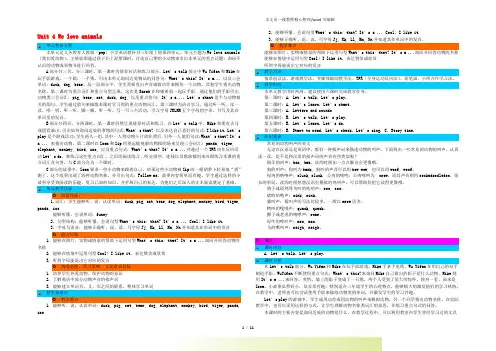
Unit 4 We love animals单元整体分析本单元是义务教育人教版(pep)小学英语教科书三年级上册第四单元。
单元主题为We love animals (我们爱动物)。
主情景图通过孩子们上泥塑课时,讨论自己塑的小动物来引出本单元的重点话题:询问不认识的动物或事物并进行回答。
A部分共三页,分三课时。
第一课时为情景对话和练习部分。
Let’s talk部分中Wu Yifan和Mike在玩手影游戏,一个做,一个猜,引出本单元询问近处物品的问答句:What’s this? It’s a... 以及三会单词:duck, dog, bear。
玩一玩部分中,学生需要发出声音或做动作来模仿一个动物,其他学生猜出动物名称。
第二课时为重点词汇和重点句型呈现,这次是Sarah在和她弟弟一起玩手影,通过他们的手影引出动物类三会词汇:pig, bear, cat, duck, dog, 以及重点答句:It’s a ... Let’s chant是个与动物相关的韵句。
学生通过韵句来操练本课时学习到的重点动物词汇。
第三课时为语音学习,通过听一听、读一读、唱一唱,听一听、圈一圈,听一听、写一写三个活动,学习字母JKLMM五个字母的字形、书写及其在单词里的发音。
B部分共四页,分两课时。
第一课时仍然呈现情景对话和练习。
在Let’s talk中,Mike和朋友去马戏团看演出,引出如何询问远处的事物的句式:What’s that? 以及表达自己喜好的句式:I like it. Let’s play是个游戏活动。
学生两人一组,其中一人将动物卡片放在背后,另外一人使用句式:What’s that? It’s a ... 来猜出动物。
第二课时以Zoom和Zip用望远镜观察动物园的场来呈现三会词汇:panda, tiger, elephant, monkey, bird, zoo, 以及重点句式:What’s that? It’s a ...并通过一个TPR动作反应活动Let’s do,来练习这些重点词汇。
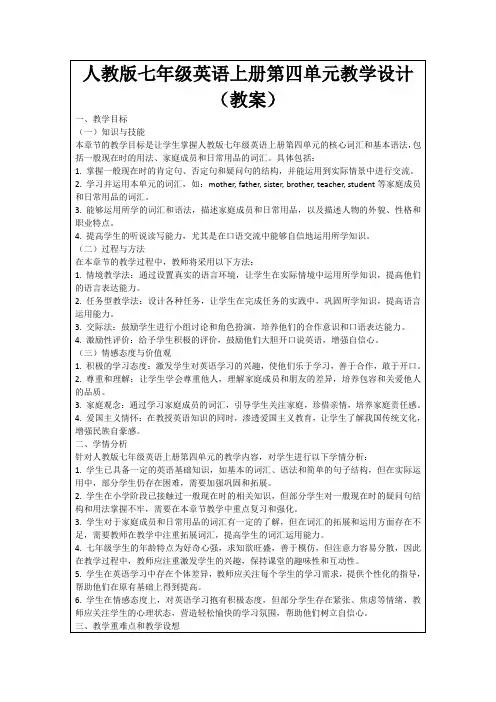
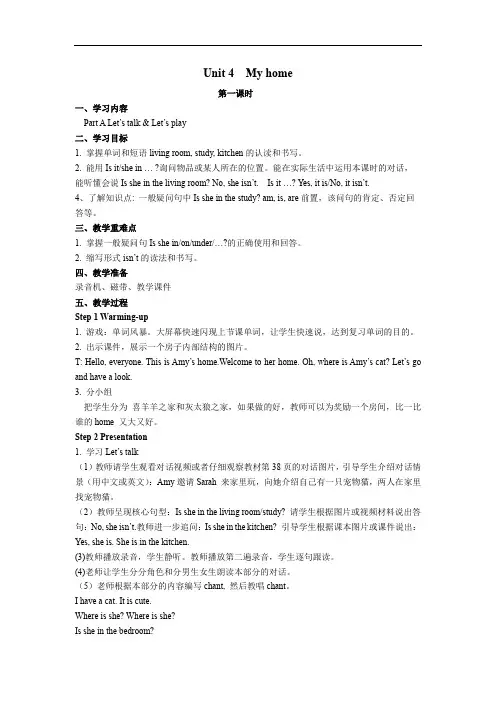
Unit 4 My home第一课时一、学习内容Part A Let’s talk & Let’s play二、学习目标1. 掌握单词和短语living room, study, kitchen的认读和书写。
2. 能用Is it/she in … ?询问物品或某人所在的位置。
能在实际生活中运用本课时的对话,能听懂会说Is she in the living room? No, she isn’t. Is it …? Yes, it is/No, it isn’t.4、了解知识点: 一般疑问句中Is she in the study? am, is, are前置,该问句的肯定、否定回答等。
三、教学重难点1. 掌握一般疑问句Is she in/on/under/…?的正确使用和回答。
2. 缩写形式isn’t的读法和书写。
四、教学准备录音机、磁带、教学课件五、教学过程Step 1 Warming-up1. 游戏:单词风暴。
大屏幕快速闪现上节课单词,让学生快速说,达到复习单词的目的。
2. 出示课件,展示一个房子内部结构的图片。
T: Hello, everyone. This is Amy’s home.Welcome to her home. Oh, where is Amy’s cat? Let’s go and have a look.3. 分小组把学生分为喜羊羊之家和灰太狼之家,如果做的好,教师可以为奖励一个房间,比一比谁的home 又大又好。
Step 2 Presentation1. 学习Let’s talk(1)教师请学生观看对话视频或者仔细观察教材第38页的对话图片,引导学生介绍对话情景(用中文或英文):Amy邀请Sarah 来家里玩,向她介绍自己有一只宠物猫,两人在家里找宠物猫。
(2)教师呈现核心句型:Is she in the living room/study? 请学生根据图片或视频材料说出答句:No, she isn’t.教师进一步追问:Is she in the kitchen? 引导学生根据课本图片或课件说出:Yes, she is. She is in the kitchen.(3)教师播放录音,学生静听。
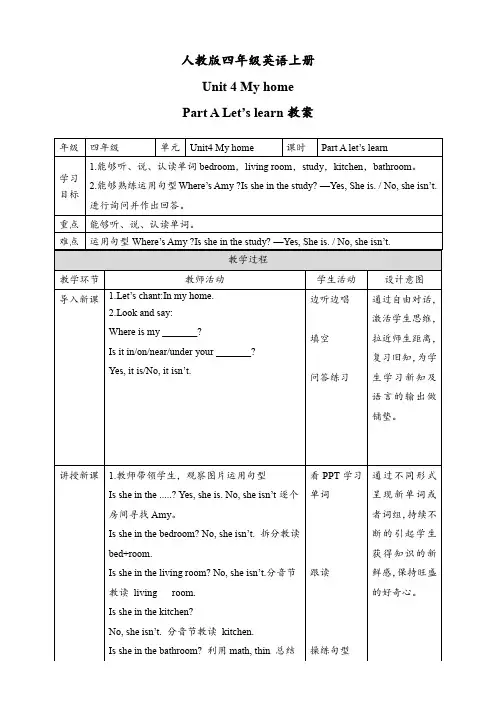
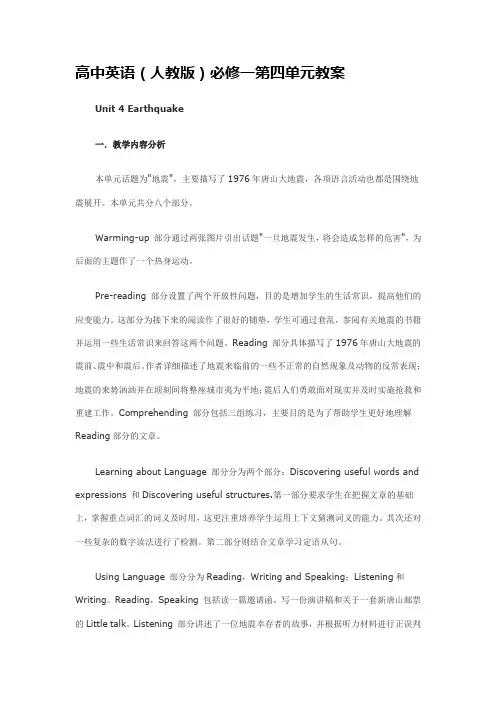
高中英语(人教版)必修一第四单元教案Unit 4 Earthquake一.教学内容分析本单元话题为"地震",主要描写了1976年唐山大地震,各项语言活动也都是围绕地震展开。
本单元共分八个部分。
Warming-up 部分通过两张图片引出话题"一旦地震发生,将会造成怎样的危害",为后面的主题作了一个热身运动。
Pre-reading 部分设置了两个开放性问题,目的是增加学生的生活常识,提高他们的应变能力。
这部分为接下来的阅读作了很好的铺垫,学生可通过套乱,参阅有关地震的书籍并运用一些生活常识来回答这两个问题。
Reading 部分具体描写了1976年唐山大地震的震前、震中和震后。
作者详细描述了地震来临前的一些不正常的自然现象及动物的反常表现;地震的来势汹汹并在顷刻间将整座城市夷为平地;震后人们勇敢面对现实并及时实施抢救和重建工作。
Comprehending 部分包括三组练习,主要目的是为了帮助学生更好地理解Reading部分的文章。
Learning about Language 部分分为两个部分:Discovering useful words and expressions 和Discovering useful structures.第一部分要求学生在把握文章的基础上,掌握重点词汇的词义及时用,这更注重培养学生运用上下文猜测词义的能力。
其次还对一些复杂的数字读法进行了检测。
第二部分则结合文章学习定语从句。
Using Language 部分分为Reading,Writing and Speaking;Listening和Writing。
Reading,Speaking 包括读一篇邀请函,写一份演讲稿和关于一套新唐山邮票的Little talk。
Listening 部分讲述了一位地震幸存者的故事,并根据听力材料进行正误判断和回答问题,旨在培养学生获取细节的能力,并通过听来模仿标准的语音和语调。

PEP小学英语四年级上册第四单元《My Home》A.Let’s talk教学设计一、教学内容本课教学内容为人教版小学英语四年级上册第四单元的第一课时,也就是A 部分的Let’s talk。
二、教材分析本单元学习的主题是家里的居室及相关设施。
本单元的知识与能力目标是A、能够听、说、认读单词bedroom, living room, study, kitchen, bathroom, bed, sofa, phone, table, fridge。
B、能够听、说、认读和在情景中运用句型 Where is she? She’s in the kitchen. Is she in the living room?----No, she isn’t. Is she in the study? ----No, she isn’t. Where are they? They are...Are they in ...? Yes, they are. No, they aren’t.询问物品、人物的位置并作出相应判断。
C、能够掌握u-e的发音规则。
情感目标是在生活中能够主动询问或对别人的询问能够热情应答以及能够感受到家的温馨,从而激发学生爱家、爱家人的情感,还有能够主动收拾物品并摆放整齐,养成良好的生活习惯。
三、学情分析四年级的学生经过三年级一年的英语学习,对英语仍保持着较浓厚的兴趣,但也有个别学生已经失去了兴趣。
在三年级时已经学习过一般疑问句Is she your mother?及其肯定回答Yes, she is.和否定回答No, she isn’t, 知道一般疑问句需要用升调来读。
四、教学目标1、知识目标:听、说、认读句型Where is she? She’s in the kitchen. Isshe in the living room?----No, she isn’t. Is she in the study?----No, she isn’t.2、能力目标:在实际情景中运用句型Is she/he/it in the...?询问物品或人物的位置,并做出判断。
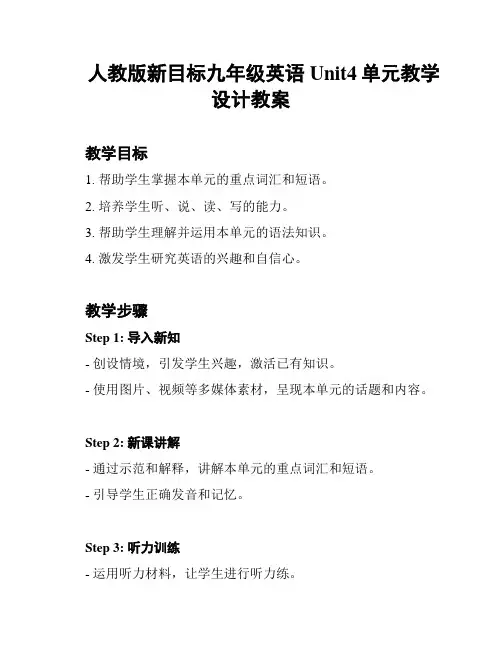
人教版新目标九年级英语Unit4单元教学设计教案教学目标1. 帮助学生掌握本单元的重点词汇和短语。
2. 培养学生听、说、读、写的能力。
3. 帮助学生理解并运用本单元的语法知识。
4. 激发学生研究英语的兴趣和自信心。
教学步骤Step 1: 导入新知- 创设情境,引发学生兴趣,激活已有知识。
- 使用图片、视频等多媒体素材,呈现本单元的话题和内容。
Step 2: 新课讲解- 通过示范和解释,讲解本单元的重点词汇和短语。
- 引导学生正确发音和记忆。
Step 3: 听力训练- 运用听力材料,让学生进行听力练。
- 提供听力策略和技巧,帮助学生提高听力能力。
Step 4: 口语练- 进行口语练活动,通过角色扮演、对话练等形式,让学生运用所学知识进行口语表达。
- 提供相关词汇和句型的情景教学,帮助学生积极参与。
Step 5: 阅读理解- 提供相关阅读材料,让学生进行阅读理解练。
- 引导学生掌握阅读技巧,如浏览、扫读、略读和深度阅读。
Step 6: 写作训练- 引导学生根据所学内容进行写作练。
- 提供写作模板和范文,帮助学生提高写作水平。
Step 7: 语法讲解- 讲解本单元的语法知识,如时态、被动语态等。
- 通过例句和练,加深学生理解和运用。
Step 8: 评价与反馈- 针对学生的表现进行评价,并提供及时反馈。
- 鼓励学生积极参与,帮助他们更好地理解和掌握所学知识。
教学资源- 人教版新目标九年级英语教材- 多媒体设备和教学素材- 相关练和评价材料教学策略- 创设情境,激发学生兴趣。
- 多媒体辅助教学,提供丰富的教学资源。
- 分组合作研究,激发学生参与和合作的热情。
- 情景教学,帮助学生在实际语境中运用所学知识。
教学评价- 针对学生在听、说、读、写等方面的表现进行评价。
- 采用课堂观察、小组讨论、作业评改等方式进行评价。
- 及时反馈学生的优点和需要改进之处。
教学反思与改进- 教师要不断反思,对课堂教学进行总结和改进。

第四单元:What's this in English?主题:本单元主要围绕学生学习英语中的基本物品名称展开,通过图片、视瓶等多种形式帮助学生掌握所学英语知识。
一、教学目标通过本单元的学习,学生能够达到以下目标:1. 掌握并能正确使用新学的英语单词:bag, ruler, pen, book, pencil, eraser, sharpener 和 t-shirt。
2. 能够听懂并能够正确回答与本单元学习内容相关的问题,如:"What's this in English?"3. 能够用英语简单介绍自己和他人所拥有的物品。
4. 能够运用所学的英语单词进行对话练习,并能够模仿相关情景对话。
二、教学内容本单元主要内容包括以下几个方面:1. 学习英语单词:bag, ruler, pen, book, pencil, eraser, sharpener 和 t-shirt。
2. 学习相关表达:What's this in English? This is a ...3. 学习与所学单词相关的日常用语表达,如:"This is my bag."、"That's my pen." 等。
4. 学习挠头与物品的连线,通过图片或实物进行相关联想。
三、教学重点1. 掌握并能够正确使用本单元所学的英语单词。
2. 能够根据实际情景正确运用所学英语进行交流。
3. 了解并能够正确回答与所学内容相关的问题。
四、教学难点1. 对于一些学生而言,英语单词的发音和记忆所带来的困难是较大的挑战。
2. 要求学生不仅能够记忆所学单词的中文意思,还要求能够正确使用这些单词进行交流。
五、教学方法1. 通过图片、视瓶和教具等形式进行课前导入,引起学生学习兴趣。
2. 老师以英语为主导语言,倡导全英文环境,使学生在情景中自然而然地学习和运用英语。
3. 通过游戏、竞赛等活动方式,激发学生的学习热情和积极性。
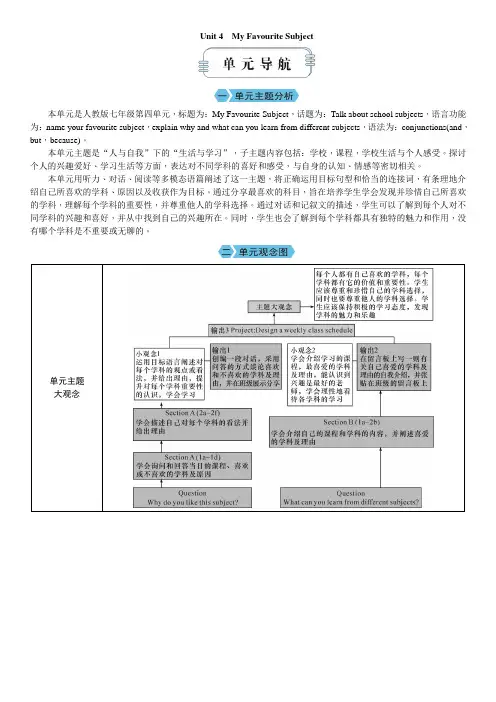
Unit 4 My Favourite Subject本单元是人教版七年级第四单元,标题为:My Favourite Subject,话题为:Talk about school subjects,语言功能为:name your favourite subject,explain why and what can you learn from different subjects,语法为:conjunctions(and,but,because)。
本单元主题是“人与自我”下的“生活与学习”,子主题内容包括:学校,课程,学校生活与个人感受。
探讨个人的兴趣爱好、学习生活等方面,表达对不同学科的喜好和感受,与自身的认知、情感等密切相关。
本单元用听力、对话、阅读等多模态语篇阐述了这一主题,将正确运用目标句型和恰当的连接词,有条理地介绍自己所喜欢的学科、原因以及收获作为目标。
通过分享最喜欢的科目,旨在培养学生学会发现并珍惜自己所喜欢的学科,理解每个学科的重要性,并尊重他人的学科选择。
通过对话和记叙文的描述,学生可以了解到每个人对不同学科的兴趣和喜好,并从中找到自己的兴趣所在。
同时,学生也会了解到每个学科都具有独特的魅力和作用,没有哪个学科是不重要或无聊的。
单元主题大观念单元语言大观念语言能力及技能语言能力:1.掌握与学科相关的词汇和常用表达,如:magic,useful,fun,important,subjects,difficult,easy,Chinese,history,maths,English,music,PE,geography,biology,IT,art,learn about the past,help me with my maths,work out maths problemsKey sentences:①—What's your favourite subject?—My favourite subject is…②—Why do you like…?—Because it's…③I'm good with numbers.④I'm not good at science.2.掌握双元音/e/,/a/,//,/əu/,/au/,/ə/,/eə/,/uə/的字母组合发音和单词连读。
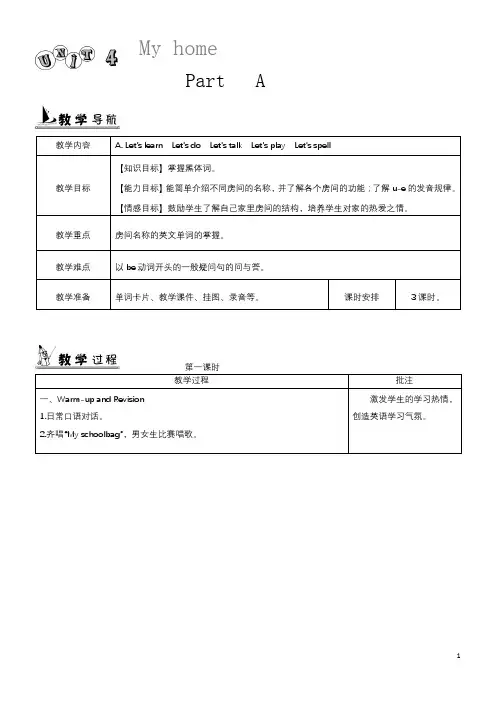
教学内容 A. Let’s learn Let’s do Let’s talk Let’s play Let’s spell教学目标【知识目标】掌握黑体词。
【能力目标】能简单介绍不同房间的名称,并了解各个房间的功能;了解u-e的发音规律。
【情感目标】鼓励学生了解自己家里房间的结构,培养学生对家的热爱之情。
教学重点房间名称的英文单词的掌握。
教学难点以be动词开头的一般疑问句的问与答。
教学准备单词卡片、教学课件、挂图、录音等。
课时安排3课时。
第一课时教学过程批注一、Warm-up and Revision1.日常口语对话。
2.齐唱“My schoolbag”,男女生比赛唱歌。
激发学生的学习热情,创造英语学习气氛。
Part A My home二、Presentation and PracticeLet’s spell1.老师拿出一支铅笔,边做“写字”的动作边说:“We use the pencilto write.”然后再拿出自己的书本,边做“读书”的动作边说:“Weuse the book to read.”帮助学生明白“use”的意思。
2.老师用课件展示出几个呆萌的动物图,学生会惊叹它们的可爱。
老师说:“Yes. They are cute.”3.老师请一位学生上讲台,假装走路不小心撞到了该学生,然后老师很礼貌地对这位学生说:“Excuse me.”引出单词“excuse”。
4.板书更多u-e单词,让学生找规律。
然后老师解释u e发音,带领学生拼读。
老师请发音标准的学生带领全班朗读。
5.老师出示含“u”的单词,带领学生拼读。
让学生判断“u”的发音和“u-e”发音是否相同。
6.做游戏。
左手代表/ ʌ/,右手代表/ju:/,老师读单词,学生根据读音来举左手或右手。
7.让学生找出“Listen, circle and say.”部分的单词,找得越多越好。
播放录音,师生共同圈单词。
8.老师挂图展示“Listen, circle and write.”部分,先让学生看图猜测所表达的意思,并圈出字母或字母组合。
人教版高一英语必修四unit4 Body language教案Part 1.Teaching goals: 教学目标1. 语言能力目标●Talk about body language: cultural differences andimprove the students’ reading ability, such as skimming, scanning,get the detailed information and understand the main idea of the text.●让学生通过阅读,能够理解并尊重不同区域的人的身体语言和其文化涵义。
●进一步训练学生推测、略读、找读、归纳内容等阅读技巧;培养学生把握篇章中心内容、归纳段落大意、获取关键信息、并且能针对阅读内容表达自己的观点的能力。
3. 情感态度目标●要学生明白身势语是不同文化的载体,在跨文化交际中起到非常重要的作用,了解肢体语言在不同含义,可以帮助学生在日常的交际中正确的注意和使用自己的体态,姿势,面部表情等,正确的理解和运用肢体语言,达到良好的交际效果。
●Body language is actions that human beings canexpress themselves and communicate with otherswithout words, with which people can avoiddifficulties when they fully understand the bodylanguage when they communicate with others. Bodylanguage plays important roles in communicating.Part 2.Teaching Important and difficult Points●重点词汇与短语greet prediction represent association dormitory canteen flight curious curiouly Colombia approach cheek defend defence major misunderstanding Jordan dash adult spoken Spain Italy likely crossroadsdefend against be likely to in general●重点句子结构与用法Yesterday, another student and I, representing our university’s student association, went to …After half an hour of waiting for their flight to arrive, I saw several young people enter the waiting area looking around curiously.I stood for a minute watching them and then went to greet them.She stepped back appearing surprised and put up her hands, as if in defence.Then Akira Nagata from Japan came in smiling, together with Japanese student.When Darlene Coulon from France came dashing through the door, she recognized Tony Garcia’s smiling face.3.Improve the students’ reading ability, such as skimming, scanning,get the detailed information and understand the main idea of the text.4.let students learn about the words and expressions about body language.Part 2. Teaching Important Points:1.Teach the students how to understand body language used in different countries or cultures as well as in different occasions.2. How does body language differ among people fromdifferent cultures?Part 3. Teaching Difficult Points:1. Let the students know that there is both positive body language and negative body language.2.to grasp the main idea of the text.Part 4.Teaching Methods:。
英语人教版选修一第四单元教案教案标题:探索英语人教版选修一第四单元《Great Scientists》教案目标:1. 通过本单元的学习,学生将能够了解和探索一些伟大的科学家及其对科学发展的贡献;2. 培养学生的阅读理解能力,提高学生的英语口语表达能力;3. 培养学生的合作学习和独立思考能力。
教学重点:1. 学习并掌握本单元中的重点词汇和短语;2. 学习并理解本单元的主要阅读材料;3. 通过小组合作学习,培养学生的合作与交流能力。
教学难点:1. 提高学生的阅读理解能力,培养学生的独立思考和分析能力;2. 引导学生运用所学知识,进行口语表达。
教学准备:1. 多媒体设备;2. 学生课本和练习册;3. 课堂小组合作学习材料。
教学过程:Step 1:导入(5分钟)1. 利用多媒体设备展示一些伟大的科学家的图片,引起学生的兴趣。
2. 与学生进行简短的对话,了解学生对科学家的了解和兴趣。
Step 2:阅读理解(25分钟)1. 学生个人阅读课本第四单元的主要阅读材料,并回答相关问题。
2. 学生小组合作,互相讨论并核对答案。
3. 教师引导学生共同探讨科学家的贡献和影响,并引导学生进行口头表达。
Step 3:课堂讨论(15分钟)1. 教师组织学生进行小组讨论,探讨科学家的贡献和影响。
2. 每个小组派一名代表进行汇报,其他小组进行评价和补充。
3. 教师进行总结和点评,引导学生对科学家的贡献有更深入的理解。
Step 4:拓展活动(10分钟)1. 学生小组合作,选择一个他们认为最有贡献的科学家进行深入研究,并准备一份简短的展示。
2. 学生进行展示,并与其他小组进行互动交流。
Step 5:作业布置(5分钟)1. 布置课后练习册的相关习题,巩固所学知识。
2. 鼓励学生自主阅读相关科学家的故事,拓宽知识面。
教学反思:本节课通过多种教学方法,如阅读理解、小组合作和展示等,培养了学生的合作学习和独立思考能力。
通过学习科学家的故事,学生不仅了解了科学家的贡献,也培养了对科学的兴趣和探索精神。
Unit4 We love animals单元备课教学目标:【知识目标】1.重点字母:Jj、Kk、Ll、Mm、Nn2.重点词汇:duck、pig、cat、bear、dog、elephant、monkey、bird、tiger、panda、zoo3.重点句型:—What's this?—It's a/an... —What's that?—It's a/an...【能力目标】1. 能够在图片、实物、情景中运用句型问答近处的物品。
2.能运用句型问答远处的物品。
3.能运用句子“Cool!I like it.”表达赞美。
【情感目标】培养学生热爱动物的情感。
教学重点:1.听、说、认读、写字母Jj~Nn,听、说、认读单词duck、pig、cat、bear、dog、zoo、bird、panda、tiger、elephant、monkey。
2.句型“—What's this?—It's a/an...”“—What's that?—It's a/an...”的运用。
教学难点:1.正确规范地书写字母。
2.熟练地运用句型问答近处的物品。
3.能在语境中区分和运用“What's this?”和“What's that?”。
教学准备:课本、人物头饰、不同颜色的蜡笔、字母卡片图、课件。
课时安排:6课时第 1 页共 14 页新人教版三年级上册英语Unit4单元教案第 2 页共 14 页第一课时一、教学内容:Part A Let’s talk & Let’s play二、教学目标1.能理解对话,能用正确的语音语调朗读对话,并能根据对话的情景进行对话角色表演。
2. 能够听说dog, duck, bear三种动物的名称。
3. 能在语境中运用What's this? It's a ... 来交流动物信息。
4. 了解英语中部分动物叫声的拟声词。
人教版四年级上册英语Unit4《My Ho me》教案2篇Lesson plan of unit 4 my home人教版四年级上册英语Unit4《My Home》教案2篇前言:英语作为在许多国际组织或者会议上都是必需语言,几乎所有学校选择英语作为其主要或唯一的外语必修课。
英语教学涉及多种专业理论知识,包括语言学、第二语言习得、词汇学、句法学、文体学、语料库理论、认知心理学等内容。
本教案根据英语课程标准的要求和教学对象的特点,将教学诸要素有序安排,确定合适的教学方案的设想和计划、并以启迪发展学生智力为根本目的。
便于学习和使用,本文档下载后内容可按需编辑修改及打印。
本文简要目录如下:【下载该文档后使用Word打开,按住键盘Ctrl键且鼠标单击目录内容即可跳转到对应篇章】1、篇章1:《My Home》教案2、篇章2:《My Home》教案篇章1:《My Home》教案教学目标1.知识目标: 1)、能听、说、认、读 study,bathroom,bedroom,living room,kitchen 等单词并能在日常生活中运用。
2)、能听懂 Let's do 中的指示语,并按照指令做出相应动作。
2.能力目标:能听懂、会说 Welcome to my home. 欢迎别人到自己家来做客的这一礼貌用语。
能实际运用句型:This is my home. You can see a bedroom....来介绍自己的家。
3.情感目标:培养学生学习英语的兴趣以及对家的热爱,鼓励学生大胆设想自己未来的家居。
教学重难点1.重点:5个表示家庭厅室的词汇以及用句型:This is my home. You can see a bedroom....来操练这5个新词汇。
2.难点:正确掌握单词bathroom,kitchen的发音。
教学过程Step 1: Warm - up(1)Before class, T and Ss sing the song“My Bedroom”after the tape.(2)Greeting.(给坐在后排的学生课程前戴上不同人物的头饰,调节一下课堂气氛) T: Hello! Boys and girls! Today there are some new friends in our classroom. Now say“Hello”to them.“Hello, my friends! Welcometo our class.”Clap your hands. T: Nice to meet you! Ss: Nice to meet you,too! T: How are you,today? Ss: Fine,thank you.(3)Ss greet with each other like that.(4)Sing a song “How are you?”.【设计思路:提前放本单元英文歌曲,让生感知语言,也为后边学唱打下基础。
Unit 4 Don’t eat in class.Section A 1a-2c【课型】听说课学习目标1.能熟练掌握本课重点词汇:rule, arrive ,hall, listen, sorry, outside, fight ,wear。
能初步口头掌握祈使句Don’t run in the hallways.2.能基本听懂含有本课重点词汇和目标语言的听力材料。
初步了解听前预测的技巧,并在听的过程中做到有目的地获取有效信息。
3.能理解遵守规则是每个学生的义务,并掌握Don’t eat in the classroom./We can’t eat in the classroom. Don’t listen to music in class./We can’t listen to music in class.并能运用目标语言谈论校规。
学习过程【自主学习】请在课前会拼读下面的单词,并熟记。
rule, arrive, hall ,listen ,sorry ,outside, fight, wear【新课导入】Step 1:Free talkT: How to be a good student?What can we do at school or in the classroom?What can’t we do?...S: We can’t...S: We can...【新知呈现】Step 2:Presentation1.根据图片提示,学习本课新词汇和句型。
Don’t eat in the classroom.Don’t arrive late for class.Don’t run in the hallways.Don’t play sports in the classroom.Don’t fight.2.看1a中的图片,将数字写到图中学生旁边。
【新知学习】Step 3: Listening 1bBefore listeningWhere are the school rules? 看课本图片中方框里的校规。
人教版小学英语四年级下册Unit 4单元整体教案Unit 4 At the farm一、单元整体分析本单元是人教版英语四年级下册的第四单元,单元的话题是“At the farm”。
本单元的内容是学习农场里一些动、植物单词,以及如何询问这些动、植物的名称和数量。
共三个版块:A 部分,B部分和C 部分。
A部分包括重点词汇、情景对话和语音,共三个课时。
第一课时通过主线人物讨论蔬菜丰收的情景呈现了蔬菜单词的词形和意义。
第二课时通过Mike与Sarah 参观农场并与农场主人对话的情景让学生感知句型:Are these carrots?Yes, they are. No, they aren’t. 第三课时通过呈现一些含有or字母组合的单词、听力活动,掌握or的发音规则。
B部分包括重点词汇和情景对话,分两个课时。
第一课时教材通过Mr Donald给Sarah介绍农场的动物的情景呈现了动物单词:horse , cows, hens,和sheep.第二课时通过Mike 与Sarah 继续参观农场的情景让学生感知句型:What are those?They’re horse.以及Are they hens?No, they aren’t.最后把最后把读和写、听音检测、看图连线、歌曲和C 部分的故事合成一个课时,重点是综合运用本单元所学词汇和句型。
在课堂教学中,首先要整体把握本单元教学内容,教学重点和教学难点,借助自制课件、网络资源、图片、实物、教材等多种方式呈现,采用游戏、儿歌、表演等多种教学方法操练,激发学生学习英语的兴趣,培养学生灵活运用语言的能力。
同时还要引导学生归纳字母组合的发音规则,让学生学会独立思考。
二、单元教学目标1. 知识目标(1)能够听、说、认读单词:cow , sheep, horse,hen ,tomatoes, potatoes, green beans, carrots。
(2)能够听、说、认读句型:Are these /those …? Yes, they are. What are these /those? How many …?。
外语系2010届毕业生毕业设计模拟教学教案指导老师:学生姓名:2010级:学号:联系电话:电子信箱:Unit 4 What are you doing?Ⅰ.Teaching Content1、Part A Let’s learn; Let’s talk;2、Read and write; Part B Let’s learn等部分的内容。
Ⅱ.Teaching Objectives1、能够听、说、读、写动词短语的ing 形式;This is Zhang Peng. What are you doing? I am doing the dishes/ reading a book....2、能运用句子“What are you doing? I am doing the dishes/….”询问别人正在做什么并作答;能够听懂、会说:Can I speak to…? Please hold on. He’s ….并能在情景中进行运用。
3、了解字母组合oo, ou, tr, tw 的发音规律及其例词的读音。
句型Grandpa is writing a letter. Brother is doing homework. Mom is cooking dinner in the kitchen. He’s writing an e-mail in the study. 能够用Mom is cooking dinner in the kitchen 等句子介绍家人正在做什么。
Ⅲ.Teaching Main Points and Difficult Points1、本课时的重点是掌握五个动词短语的ing形式,能够理解下一课时的主要句型:What are you doing?并能够用I am doing the dishes/….作答;What are you doing? I am….的书写;掌握He/She’s ….2、难点是:动词短语ing形式的读音。
培养学生在实际情景中运用对话的能力;句子Do you want to go to the Children’s Center?的理解和朗读,以及字母组合oo, ou, tr, tw 的发音规律;以不发音的字母e结尾的动词ing形式的变化。
Ⅳ.Teaching StepsStep One:1、热身:教师放歌曲“What are you doing?”的录音。
2、教师出示一个动作短语卡片,如: do the dishes 说I can do the dishes,引导学生说Me too,然后教师用其他的动词短语卡片进行替换,带领学生继续操练。
Step Two:Let’s lean1、教师放映幻灯片,让学生说出图片中的“我”正在洗盘子。
教师再说出“洗盘子”用英语说是“doing the dishes”;教师在do后面加上ing,并写出句子“I am doing the dishes.”。
教师再问:“‘你正在做什么’用英语怎么说?”并写出“What are you doing?”。
教师领读三遍“What are you doing? I am doing the dishes.”下面依次讲解answering the phone/cooking dinner/reading a book/drawing pictures及“What are youd oing? I am answering the phone/cooking dinner/reading a book/drawing pictures.”2、教师出示“读书、做晚饭、画画、洗盘子、接电话”五张动作图片,让学生看图片中的“我”依次说出对应的动词词组reading a book, cooking dinner, drawing pictures, doing the dishes,answering the phone.3、教师分别出示做晚饭、画画、读书、接电话动作图片让学生根据提示“What are you doing?”回答问题I am cooking dinner/drawing pictures/reading a book/ answering the phone.4、Let’s chant教师播放该部分的录音,让学生听录音跟读两遍后试着分组说唱歌谣。
Step Three:1、Let’s talk(1)让一名学生抽取一张单词卡片,教师带领其他学生问:What are you doing?抽取词卡的学生边做卡片上相应的动作边回答:I am….请五至六名学生轮流上台抽卡片,直到全班学生都初步会说句型What are you doing? 再进行下面的活动。
(2)学生五人一组。
教师问各组的第一名学生:Hello. What are you doing? 每组的第一名学生回答后转身问后面的学生:What are you doing? 依次类推,每名学生的回答不能与同组前面学生的回答重复,看哪个小组最先完成游戏。
(3)学生拿出自己制作的图卡或学具,两人一组操练:What are you doing? I am….(4)教师放Let’s talk部分的录音,学生跟读。
(5)出示Let’s talk 中的图片和道具电话,指导学生进行替换练习。
2、Pair work学生两人一组,每人在一张纸条上面写一个动词短语的ing 形式,如:doingthe dishes,然后两人交换纸条,分别将纸条卷起来做道具,根据各自手中纸条上的内容模拟打电话。
Step Four:Read and write1、教师指着黑板上的简笔画,问:What is he/she doing? 引导学生回答:He /she’s singing/ dancing/playing ping-pong/drawing pictures/playing the piano.2、教师在简笔画的外围画一幢房子的轮廓,提问:Do you know where it is? Where are the children? 自然引出Children’s Center.3、教学:Do you want to go to the Children’s Center?the Children’s Centergo to the Children’s Centerwant to go to the Children’s Cente rDo you want to go to the Children’s Center ?4、教师说:Now, Zhang Peng calls John. What are they talking about ? Listen. 教师放Read and write部分的录音,学生跟读。
5、教师向学生展示本部分的挂图,对This is Zhang Peng. 的用法作必要解释。
告诉学生打电话时若想告诉对方你是谁,不能说I am ...而应该说This is /It’s ....6、教师指导学生书写四会句子,看谁写得又快又好。
7、Pronunciation(1)出示单词:cool, goose, school,boots 让学生读一读,试着找出oo的发音规律,然后教师出示字母组合ou和单词soup,一起归纳发音规则。
同法学习字母组合tr, tw的发音规律。
(2)教师放该部分的录音,学生跟读,引导学生看图片理解句意。
然后,请几名学生试着朗读饶口令。
(3)教师出示一些包含字母组合oo,ou,tr,tw的单词,让学生试着读一读,检测学生掌握字母组合发音规律的情况。
Step Five:Le t’s learn1、在动作接力赛的最后引出本课第一个动词短语:listening to music教师板书并带读。
2、教师出示cleaning the room的图片,提问:What’s he/she doing? 引出新词。
3、采用做动作、描述等方式引出washing clothes, writing a letter, writing an e-mail.4、做“高低音”游戏:教师指着黑板上的图片带读短语,如果教师声调高,学生就大声跟读,反之则不跟读。
5、教师向学生展示Let’s sta rt 部分的挂图,提问:What is he/she doing?引导学生按照提示说话。
6、教师放Let’s learn 部分的录音,学生听录音认读短语。
Let’s chant教师放第四十九页的歌谣录音,学生认真听。
教师再放一遍录音,学生跟读。
然后师生一起说唱歌谣。
Step Six:Let’s try1、学生听录音,做Let’s try部分的练习Listen and tick;教师在黑板上写好下面两列单词,让学生连线并正确读出短语。
listening to musicwashing a letterwriting clothescleaning an e-mailwriting the roomL et’s talk1、做“猜一猜”游戏:教师拿出Let’s talk部分的挂图,但要将四幅配图分别用四张白纸遮盖好,问学生:What is she doing?学生猜对一个,教师就把这张图上的纸拿掉,直到学生全部猜出为止。
2、教师拿出cooking dinner的图片提问:What’s she doing? Can I speak to her, please?引导学生回答:She’s cooking dinner, Please hold on.教师带读答句。
3、同桌之间用电话等小道具操练对话。
4、从学生的对话中引出Mom, there’s a call for you. 教师可借助体态语言帮助学生理解这句话的意思,然后带读。
5、教师放Let’s talk部分的录音,学生跟读。
6、同桌学生进行对话替换操练,然后教师指定几组学生在学生面前表演。
Let’s play学生两人一组,随意将人名与动词短语的ing形式一一连线。
然后根据各自的连线情况进行问答,如:What is Chen Jie doing? She’s ….Good to know帮助学生了解我国及主要英语国家的紧急救助电话号码。
Step Seven:1、做“读读、贴贴”游戏:教师出示短语卡,学生齐读后,请学生把短语卡贴到相应的动作图下,边贴边说出一个句子:He / She is….Read and write2、做“加句子”游戏:学生五至六人一组,第一名学生多一个描述家庭成员的句子:如Mom is cooking dinner in the kitchen.第二名学生先重复前面学生说的句子,然后再说一个不同的句子,如:Mom, is cooking dinner in the kitchen, Dad is reading a newspaper in the study.依次类推。